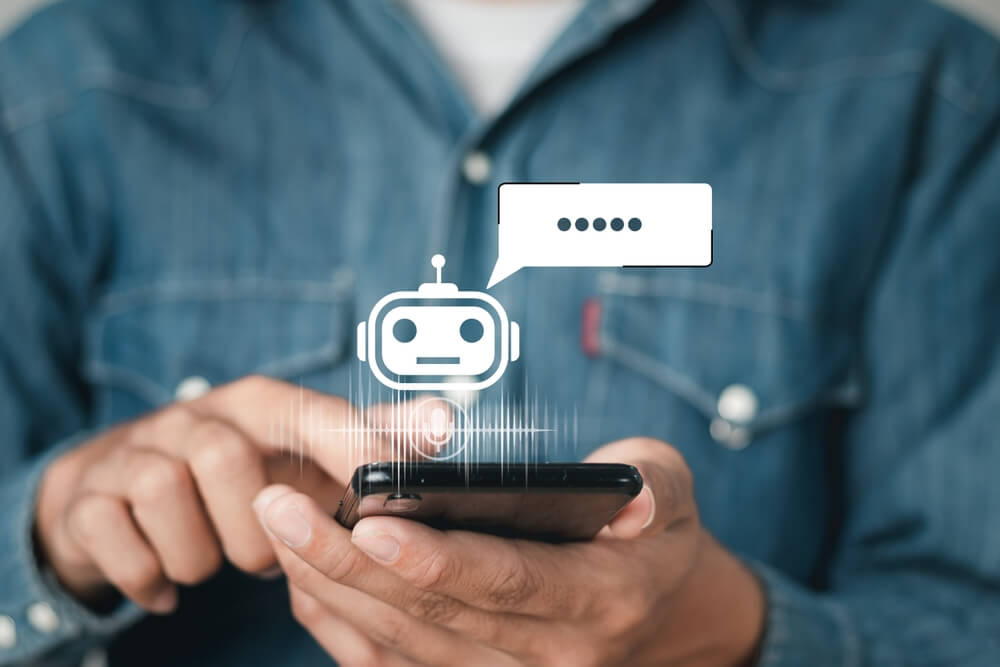
Use Chatbots and Conversational AI to Gain eCommerce Leads
Ecommerce companies benefit from chatbots and conversational AI, especially when generating quality leads. Chatbots for ecommerce provide real-time engagement and personalized interactions, offering product recommendations and seamlessly guiding users through the purchasing process. A full service eCommerce SEO agency can design chatbots to fit your needs for a reasonable cost.
By simulating human-like conversations, chatbots enhance customer interaction, creating a more personalized shopping experience and significantly impacting ecommerce sales by capturing leads.
Let us look at how ecommerce companies use chatbots and conversational AI to maximize their lead-generation efforts. This blog post covers the following points:
- Integrating chatbots with ecommerce platforms.
- Personalization of marketing strategies.
- Enhancing customer service.
- Leveraging chatbots for lead qualification.
We will also touch on measuring chatbot interaction success. Let’s go!
Are you struggling to elevate your e-commerce game? Watch this video to learn how DAP can do that for you!
Integrating Chatbots with Ecommerce Platforms
Integrating chatbots into ecommerce makes lead generation more efficient, allowing marketers to build quality leads. It involves leveraging application programming interfaces (APIs) to access product catalogs, user accounts, and transactional data.
Technical implementation incorporates natural language processing (NLP) to effectively understand user queries. Solid security measures and user authentication protocols help protect sensitive data during interactions.
Seamless integration with payment gateways, order processing systems, and CRM platforms ensures a smooth user experience for customers. Chatbots facilitate transactions and personalized interactions for ecommerce companies and customers. Consider these best practices for seamless chatbot integration:
- Maintain consistent branding elements and design aesthetics across the chatbot interface and the ecommerce platform.
- Use the same color schemes, fonts, and visual elements to create a cohesive user experience, reinforcing brand identity and familiarity.
- Ensure that the chatbot offers a consistent experience across various devices and channels. Whether via a website, mobile app, or social media platform, the chatbot's functionalities, responses, and appearance should remain uniform for a seamless omnichannel experience.
- Prioritize real-time synchronization of data between the chatbot and the ecommerce platform. Product availability, pricing, inventory status, and user information should be updated instantly to provide accurate and up-to-date information during interactions.
- Design the chatbot's conversational flow to maintain context throughout interactions. Make sure that users can ideally continue conversations or transactions without repeating information, with contextual understanding and continuity in dialogue.
- Conduct thorough testing across different scenarios to identify and rectify integration issues. Continuously optimize the integration to improve performance, responsiveness, and user experience based on feedback and analytics data:
Following these best practices ensures that the integration between the chatbot and the ecommerce platform remains seamless, providing users with a consistent and unified experience across various touchpoints.
Promoting Personalization through Conversational AI

Conversational AI uses machine learning and natural language processing to understand user preferences, behavior, and context, allowing highly personalized interactions. By analyzing past interactions and user data, conversational AI can offer tailored product recommendations, suggestions, and guidance during conversations.
Personalized experiences built through conversational AI enhance customer engagement by providing relevant and timely information, creating a deeper connection between the user and the brand. It increases customer satisfaction and influences lead conversion rates because tailored recommendations cater to individual needs, increasing conversion and customer loyalty.
These techniques help marketers implement personalization using conversational AI:
- Implement user profiling by collecting and analyzing user data during interactions. Gather information on preferences, past behavior, demographics, and purchase history to create comprehensive user profiles.
- Utilize NLP algorithms to interpret and understand user intents, sentiments, and context during conversations. Contextual understanding allows the chatbot to deliver more relevant and accurate responses tailored to the ongoing discussion.
- Employ behavioral analytics to track user behavior patterns and interactions with the chatbot. Use predictive modeling to anticipate user preferences, needs, or potential actions, enabling proactive and personalized recommendations.
- Tailor content dynamically based on user preferences and behavior. Provide personalized product recommendations, content suggestions, or offers that align with individual user interests.
- Implement machine learning models within the chatbot to continuously learn from user interactions. Adapt and refine recommendations, conversation flows, and personalization strategies based on real-time data, ensuring that the chatbot becomes adept at providing personalized experiences over time.
These techniques allow businesses to harness the power of conversational AI to deliver highly personalized interactions, recommendations, and experiences to users. This ultimately enhances engagement, satisfaction, and conversion rates.
Enhancing Customer Service with AI and Chatbots
Automation, like chatbots and AI, improves customer service by answering questions quickly and correctly. Chatbots understand and address customer queries efficiently through NLP, offering round-the-clock support.
AI-driven chatbots handle routine tasks such as providing information, troubleshooting common issues, and directing users to relevant resources, freeing human agents to focus on more complex inquiries.
Their ability to learn from interactions makes certain of continuous improvement in resolving customer issues swiftly and accurately, leading to an enhanced customer service experience. These common customer service scenarios show how chatbots manage customer service:
- FAQs and information retrieval. Chatbots handle frequently asked questions by providing immediate responses regarding product details, shipping information, company policies, and general inquiries. They retrieve data from databases or knowledge bases to address customer queries instantly.
- Order tracking and status updates. Chatbots assist customers in tracking their orders, providing real-time updates on order status, shipment tracking, and estimated delivery times. Users are able to inquire about their orders without needing to contact customer support.
- Technical support and troubleshooting. Chatbots guide users through technical issues by offering troubleshooting steps, instructions, or guides. They assist in diagnosing common technical problems and provide solutions or escalate complex issues to human support if necessary.
- Appointment scheduling and reservations. Chatbots facilitate appointment scheduling, table reservations, or booking services by guiding users through available time slots, confirming bookings, and sending reminders. This streamlines the reservation process, offering convenience to customers.
- Account management and password resets. Chatbots help users manage their accounts by enabling functions such as password resets, account information updates, or subscription changes. They guide users through account-related procedures, reducing the need for direct human intervention for common inquiries.
These scenarios showcase how chatbots efficiently handle customer service tasks, providing timely assistance, information, and guidance. These ultimately enhance the overall customer experience.
Leveraging Chatbots for Lead Qualification

Chatbots for ecommerce can qualify leads by asking strategic and targeted questions tailored to gather specific information about a prospect's needs, preferences, and buying intent. Through predefined questionnaires or conversational flows, chatbots analyze responses, scoring leads based on budget, timeline, or interest level criteria.
By evaluating these responses in real time, chatbots filter and prioritize high-quality leads, ensuring that only qualified prospects meeting specific criteria are directed to sales teams for further engagement.
Chatbots streamline the lead qualification process, enabling sales teams to focus on leads most likely to convert, optimizing productivity, and increasing successful conversions. Marketers use the following techniques to effectively leverage chatbots for lead qualification:
- Develop a set of targeted and strategic questions within the chatbot's conversation flow. Tailor these questions to gather specific information about the lead's needs, challenges, budget, timeline, and decision-making process.
- Implement lead scoring mechanisms within the chatbot to assign scores based on the lead's responses. Use this scoring system to segment leads into different categories, such as hot, warm, or cold leads.
- Design personalized conversational flows based on different buyer personas or industry segments. Customize the chatbot's interactions to resonate with various leads' diverse needs and preferences.
- Integrate the chatbot with customer relationship management (CRM) systems to seamlessly transfer lead data and interactions. This guarantees that the chatbot will store and make all pertinent data available to sales teams, facilitating easier lead handoffs.
Regularly analyze and refine the chatbot's performance and conversation flows based on user interactions and feedback. Optimize the chatbot's questionnaire, scoring methods, and conversation tactics to improve lead qualification accuracy and effectiveness over time.
Measuring the Success of Chatbot Interactions
Continuous monitoring and improvement of chatbot interactions optimizes performance and helps achieve business goals. Analyzing performance data helps understand user behavior, identify bottlenecks, and assess the effectiveness of the chatbot's responses.
This data-driven approach enables businesses to make informed decisions, refine conversation flows, and adapt strategies to better align with user needs and preferences. By regularly evaluating user satisfaction, engagement rates, conversion rates, and resolution times, businesses can improve interactions, user experience, and lead generation.
These top metrics are critical in evaluating the effectiveness of chatbot interactions:
- Engagement rates. Measure the level of user interaction with the chatbot, including the number of sessions, messages exchanged, and the duration of each interaction. Higher engagement rates indicate active user participation and interest in the chatbot's functionalities.
- Customer satisfaction scores (CSAT). Assess customer satisfaction levels post-chatbot interactions through surveys or feedback. CSAT scores help gauge how well the chatbot met user expectations and resolved queries, providing insights into user satisfaction.
- Resolution or completion rates. Evaluate the chatbot's ability to successfully resolve user inquiries or complete tasks. Monitor the percentage of interactions where the chatbot successfully addressed user needs without requiring escalation to a human customer agent.
- Conversion rates. Track the number of leads generated or conversions achieved through chatbot interactions. Measure the percentage of users who took desired actions, such as purchasing, signing up for a service, or scheduling an appointment after interacting with the chatbot.
- Retention and repeat usage. Analyze user retention and repeat usage rates to determine the chatbot's effectiveness in encouraging users to return for further interactions. A high retention rate indicates that users find value in the chatbot and are willing to repeatedly engage with it.
These metrics provide valuable insights into different aspects of chatbot performance, helping businesses assess the influence of chatbot interactions on user engagement, lead generation, satisfaction, conversion, and retention, enabling continuous improvement and strategy optimization.
Summing Up
Chatbots and conversational AI present a transformative potential in generating ecommerce leads by revolutionizing customer interactions. These technologies efficiently guide users through the purchasing journey through personalized engagement, immediate responses, and tailored product recommendations.
Ecommerce businesses have to use chatbots and conversational AI for their digital strategy, enhancing user experiences, boosting lead generation, and staying competitive in a rapidly evolving online marketplace. Their ability to engage customers, streamline processes, and deliver personalized experiences makes them indispensable tools for lead generation.
What untapped opportunities could conversational AI unlock in your lead-generation strategy? Find the answers today. Contact the experts in chatbots for ecommerce marketing. Contact Digital Authority Partners (DAP) now.
Want To Meet Our Expert Team?
Book a meeting directly here




